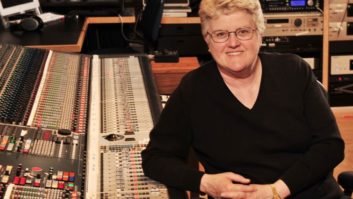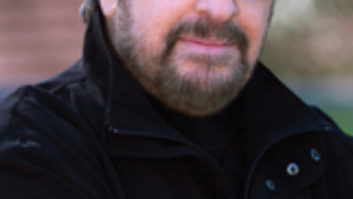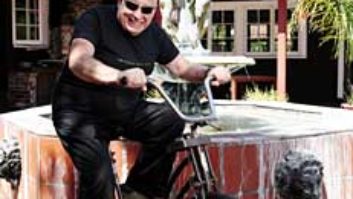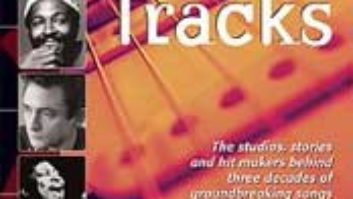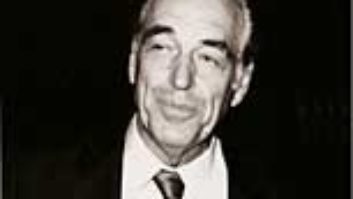You do whatever you have to do to get it on tape. That’s always been my feeling.
I didn’t like going in the studio for 24 hours straight, because I thought your ears were gone; I knew mine were.
Like it or not, the great New York engineer/producer Roy Halee will forever be linked with Paul Simon and Art Garfunkel; he recorded every album Simon & Garfunkel made, co-producing a couple of them, and did many of Simon’s solo records and Garfunkel’s acclaimed first album. That’s quite a body of work right there — sales in the millions, and honors including Grammys and a number of other awards. But during the course of more than 40 years in the recording business, Halee has amassed many other credits, too, covering a broad range of musical styles, and it is for his entire career that he has been named this year’s recipient of the coveted TEC Hall of Fame award.
Did you know, for example, that Halee worked with The Yardbirds? That he engineered the classic ’60s jam disc Super Session? That he recorded and produced great albums for ’70s funksters Rufus? It’s a helluva resume, stretching from the early ’60s to the present, and including such name artists as Peaches & Herb, Chad & Jeremy, Moby Grape, The Cyrcle, The Byrds, Barbra Streisand, Blood Sweat & Tears, Edie Brickell, Neil Diamond, Journey, Willie Nelson, John Klemmer, Boz Scaggs, Laura Nyro, Ladysmith Black Mambazo, The Roches, Mark Almond and many, many others. He’s one of the guys the term “golden ears” was invented to describe, a master engineer with impeccable taste and an encyclopedic knowledge of both musical and technical matters.
We caught up with Roy Halee this summer at his Florida home…
How did you get your start in the business? And are you from New York?
Yes, I grew up on Long Island. How I got my start is I worked for CBS Television. I started at the bottom there, pushing cameras and booms around in the late ’50s.
Were you technically inclined?
Not really. I was studying to be a classical trumpet player and I got pretty far in that, but at some point I sort of gravitated over toward broadcasting and got in at CBS. I graduated up in CBS Television to being a straight audio man — doing the Goodson-Todman game shows and other things. I did The $64,000 Question for a while, which was the Number One-rated show for a long time. It was all live, so I got broken in pretty well.
Then I got caught in a union layoff because all the shows were moving out to Hollywood. I never would’ve left CBS Television had I not been laid off. But when it happened, I went right across the street to Columbia Records and ended up in an editing cubicle for about a year-and-a-half.
What did that involve?
Just editing tape — classical, pop, you name it. I did a lot of classical editing.
Is this stereo by this point?
Stereo, and some mono. It was a lot of editing 3-track master tapes, working with the various producers.
Who were some of those Columbia producers you worked with in that era [early ’60s]?
Oh geez, there were so many — everyone who was on staff at Columbia at the time. Al Kascha, who went on to win Academy Awards, Tom Wilson, Bob Johnston, Teo Macero, who I did some jazz stuff with…John McLure, Thomas Shepard and Paul Meyers, they all did classical. You had to edit everything. I got a tremendous amount of experience editing tape. Plus, you would also mix down tapes from 3-track to stereo and mono to be mastered.
I assume this was all on the label’s custom-built consoles.
Correct. In those days, Columbia did everything in-house — the consoles and studios and editing rooms. We had a vast amount of editing cubicles — I couldn’t guess how many we had. And mastering rooms, too.
So I was a year-and-a-half doing that, to the point where I was going crazy being cooped up in that editing room, and quite frankly, I threatened to leave. I lined up a couple of jobs outside — I wanted to get into the studio; I thought of myself as a studio guy. They said, “No, you’re not going anywhere. We’ll put you in the studio.” So they put me in the studio, and I started doing sessions almost immediately.
Do you remember your first session?
I very much indeed remember my first session: It was Bob Dylan, “Like a Rolling Stone.”
Wow!
“Wow” is right. I didn’t know what the hell I was doing. But I ended up doing that album [Highway 61 Revisited], and that evolved into my doing Simon & Garfunkel and the Lovin’ Spoonful and a couple of dates with The Yardbirds. And then interspersed with that was all the pop stuff that Columbia had at the time. They sent me down to the Bon Soir nightclub and I did Barbra Streisand’s first session.
I’m intrigued by the thought of you being thrown into a session with Bob Dylan. I mean, here you are, you’ve been in television and then doing editing for a while, and, all of a sudden, you’re in a room with this strange guy and what turned out to be a revolutionary sound…It must have been pretty jarring for you, no?
It was. I was nervous, to say the least.
I gather there was sort of an uneasy relationship between some of the mid-’60s groups and the recording world, which was so conservative on many levels. How did you bridge the gap?
It was tough, no question about it. I think I was able to do it successfully because I enjoyed the rock and pop stuff so much. I found it really creative, because on those records you could sort of stretch what you knew and come up with all kinds of sounds and mic techniques. Whereas with the classical stuff, it was pretty straight-ahead: “This mic goes here, this mic goes here, this mic goes here; that’s the way we do it.” It was more like television in that it was very schooled and orderly. But I liked that Dylan would say, “Hey, I want to do my vocal over here by the drums.” Okay, well, how am I going to do that? That became a challenge. So there was a lot of experimentation, and not everything worked out every time, of course, but that attitude was good, and I think it helped me in later years.
Had you been schooled at all about, say, what was happening over at Atlantic with Tom Dowd and Ahmet Ertegun?
Certainly we were aware of what they were doing, but, quite honestly, I didn’t pay that much attention to it because I was too busy doing my own thing. I had a lot of outside clients coming in who had heard about this young guy who would try anything and they wanted to work with me. I brought in a lot of younger acts who previously wouldn’t have thought of recording for Columbia, which was considered sort of square at the time.
Well, it was Mitch Miller’s label after all.
That’s right. Actually, Mitch Miller’s the one who brought me in. I never actually worked with him. But he was a great, great musician.
Was it hard to switch back and forth between, say, the Lovin’ Spoonful and a big pop session?
No, I can’t say it was. One might be a little more challenging than another. You go into the studio with a 70-piece orchestra and you’re doing it live — that was a helluva challenge. You couldn’t spend two hours getting a drum sound, obviously. You had to get it right away. But then a group like the Lovin’ Spoonful was challenging in its own way. You’re working to really capture the sound of the group, and that’s not always easy. I really liked them. John Sebastian was really great to work with. They got a little crazy sometimes, but they were a lot of fun. To cut a record like “Summer in the City,” and watch it go up to Number One and sit there for weeks — that was a ball; it was really thrilling.
I imagine that in the pre-Revolver days, bands pretty much let the engineers and producers call the shots in terms of how the records should sound…
That’s right. We were mostly doing live tracks, maybe overdub a few things, and then put vocals on. But we’d experiment, too. Like on “Summer in the City” that explosion is from putting a mic in a garbage can that we had in the studio and banging it.
Did the highly experimental approach of George Martin affect you the way it did so many engineers and producers?
No, not really. Like I said, I had my own thing going.
But it certainly affected musicians and producers in terms of making them aware of the potential of the recording studio.
That’s true. As you said, I think it affected some producers quite a bit. I worked with a guy out in L.A. who loved to imitate everything The Beatles were doing — Gary Usher. He loved to copy them. “Here, listen to this record, Roy,” and it would be some phasing thing; no big deal. Actually, I used a lot of that on Simon & Garfunkel.
At what point did you hook up with them originally?
Well, I was there for the audition. Then Columbia signed them, and Artie said, “Can’t we have the engineer we had on the audition? We really like him.” And I ended up doing all their sessions; every one.
Can you talk a little about their evolution in the studio? A record like “The Sounds of Silence” had a pretty distinct sound, but that’s very different, obviously, than what we later hear onBookendsorBridge Over Troubled Water.
Well, “Sounds of Silence” was originally the audition, and then [producer] Tom Wilson and I went in the studio and overdubbed the studio musicians, and it came out as a single and it was a big hit. After that, we brought the same musicians in the studio and went on from there on the album.
How much control did Paul Simon have at that point over the music and arrangements and all?
Total. Or just about total. Artie was more into the vocal backgrounds, the pretty harmonies, etc. But Paul was the writer, and he really had a vision for what he thought we should do. Still, he would bounce ideas off of us; he’d come into the studio and say, “What do you think of this?” and he’d play something, and Artie would say what he thought, and I’d say what I thought, and we’d go from there.
Was theirs the typical story of each record taking longer than the previous one? An album likeBridge Over Troubled Waterhas so many styles on it; it must’ve been harder to pull off in the studio.
Well, it also didn’t help that Artie went off and did a movie [Carnal Knowledge], so that sidetracked us a bit. Also, Paul is not the fastest writer in the world. He wasn’t one of those guys who could just grind it out — boom, boom, boom — like he did more in later years. But, yes, that record did take a long time. Isn’t it that way with all successful groups? I think that’s normal.
What was the separation between producer and engineer in those days.
Total. Although it wasn’t with me; not at all. The engineer was the engineer; the producer was the producer. The producer called the shots in the studio. He was running the session, and the engineer followed along. He was considered a good engineer if he didn’t get in the way. I was fortunate in that they drew me in more musically; they picked my brain more — “What do you think?” “What kind of sound would go well with that? What texture might go well with that?” “Well, how about a piccolo trumpet and a tuba in a church on that?” So we’d go and do that, like we did on “The Boxer.” We went into the chapel at Columbia University to overdub a piccolo trumpet and a tuba.
So that’s not something that was planned way in advance.
No, we were always experimenting with different combinations, different sounds. And you know, all the Paul Simon sessions were “head dates”; none of them were arranged. You go in and pick the brains of the best musicians in the world. You don’t put a chart in front of a Hal Blaine or a Larry Knechtel. You let them do what they do — draw on that.
You did Blood Sweat & Tears’ classic second album, which I always thought was a sort of left-field success, because horn bands weren’t exactly hot at the time…
That’s true, though I always thought it was very commercial-sounding music. Of course, I had no idea it would be that kind of success. Horns on a rock ‘n’ roll record? It was almost unheard of. But the tunes were strong enough. And they had a great singer [David Clayton Thomas].
Did you keep an ear on pop radio at the time? Radio in the late ’60s was so eclectic, it must’ve been hard to make any generalities about what was “hot.”
I listened all the time. You’d hear what was making it and what wasn’t. I can’t say I changed anything I was doing because of what I was hearing, but it was important to know what was out there. So, yeah, I listened…and then I’d go home and listen to classical music to clear my head. You’ve gotta have that, man, or you burn out.
Were your bosses at Columbia comfortable with all the sonic experimentation you were into?
Up to a point. You know, I really wanted more tracks, and for Columbia to invest in an 8-track machine or, later, 16-track, it didn’t just involve me — it involved studios in Hollywood and Nashville, because they wanted their studios to be the same everywhere. It was a big investment any time they wanted to make a change.
You were instrumental in setting up some of the other Columbia facilities, weren’t you?
Well, they gave me my own studio in San Francisco. Clive Davis basically told me I could build the studio and do whatever I wanted out there.
But hadn’t you been in L.A. right before that?
Yes, but that studio was there already. I did a lot of recording in L.A. with Paul and Artie [Simon and Garfunkel]. I cut The Byrds there, too.
And that studio was like the one in New York, equipment-wise?
Right; it was Columbia equipment. Which some of the groups were not particularly crazy about, to be very honest. You know, groups are very fickle about studios. But Paul Revere & The Raiders always worked in the big Columbia studio [in Hollywood]. The Byrds did most of their sessions there. I liked working out there, but the union was a little strangling.
How so?
Creatively. If you wanted to do something really strange with a lot of machines, they didn’t like it. If I had four or five tape machines running with echoes and reverbs — because you didn’t have digital delays in those days, of course — I’d line ’em up in the hallway of the studio, and the union didn’t like that. “What do you need all those machines for?”
So did CBS want to open the San Francisco studio because at the time it seemed like it had an important music scene?
Yes, they wanted to get more active in the business there. Janis Joplin was there at the time. Santana. There were a lot of acts there; it was flourishing, and Columbia wanted to get involved in it. What happened, though, is that I ended up bringing a lot of my own acts in there. I brought in Blood, Sweat & Tears, and we cut a lot of Paul Simon’s first album there. Then Art Garfunkel came out and we did a lot of his album there.
When there was the transition from Simon & Garfunkel to Paul doing his solo material, was there much of a difference in the way he worked in the studio?
Well, he wanted to do that first album in a sparse, almost homemade way; almost like a demo. No big arrangements or big flourishes; just straight ahead, his voice way out front.
But then with his next album,There Goes Rhymin’ Simon,it was back to the big productions.
Right, that was very arranged. Phil Ramone produced that one.
When [Simon’s]Gracelandcame out in 1986, obviously there was a lot of talk about “world music” and all that, but the fact is, he’s always been into different world music strains, whether it was the Peruvian “El Condor Pasa” or the various Latin and Caribbean things he did — “Cecilia,” “Me & Julio.”
That’s absolutely true. It’s because he’s always looking for something different.
So did the San Francisco studio have the same equipment as the other CBS studios?
Yes, for the most part. It had the same custom console. It had a lot of good tube electronics — like the old RCA compressor/limiters, which were really good-sounding units. And we had the old Pultecs and the UREI 1176s. And, of course, the microphone selection was out of this world. Today, you can’t even get half of those microphones. I must’ve had 10 M49s and 10 U67s, KM84s, AKG C-12s for classical work. What a wealth of microphones!
What finally happened in San Francisco? You left in the mid-’70s…
I eventually got really tired of it, because I had to keep bringing musicians in from L.A. I tried using Bay Area players. I brought in San Francisco Symphony players a few times. And there were a few horn players. I brought in Jerry Garcia a couple of times, which was nice. But Hal [Blaine] was down in L.A., and so many of the regular musicians I liked to use were down there, and then I got involved with Albert Hammond and I was spending more time there than in San Francisco, so I figured I’d go back down there. I just couldn’t find the musicians I needed to help me.
How did you feel about the physical change in studios during the ’70s? The rooms became deader, there was a move away from live tracking in favor of building layer by layer from the drums and bass up…
I didn’t like it. I like ambience and I like to cut a good live track with a band. I’ve gone into the studio with producers and heard them say, “Hey, that’s leaking! That’s leaking!” And I say, “That’s right, I like that! Listen to the overall sound!” If you don’t have the leakage, the sound suffers. You have to have some ambience. Of course, sometimes you can’t, and obviously you’ve got to overdub, but even there I’ll do whatever I can to get some ambience happening. So, going into these dead rooms and putting all these guys in their little cubicles…I didn’t like it at all. I liked studios where you could do both — like the old Mediasound in New York. It was a very live room, but you could deaden it if you wanted to for some reason.
But did you do it?
No, I didn’t. It was very challenging, for instance, doing Graceland in Africa, because I had to isolate these guys so that we could cut up the tape, take instruments out that we didn’t want, replace them with other instruments. Yet I wanted them all close so they had eye and ear contact without headphones. So how do you do that without building all these little houses?
What did you do?
I’d have to show you. It’s complicated. I could write a book on the technical side of making Graceland. Briefly, though, it was mic placement, person placement and a few goboes. You’d be surprised what you can do in a room that’s fairly dead, without any baffling, if you do a sensible setup. Musicians love to have eye contact. I’ve found that the drummer always needed phones, but other musicians really didn’t need them and didn’t want them, because nine out of 10 times the headphone feed is bad.
Did you build the rhythm tracks and spend endless hours on drums sounds?
Oh, sure. You do whatever you have to do to get it on tape. That’s always been my feeling.
So you wouldn’t have recommended against working that way?
No. It’s in the nature of being experimental. I go to a studio in Africa, I see what I’ve got or what I can get, and I think, “What do I need to do to get this on tape?” So I go out and listen to each musician and hear what’s happening in the room overall and between each of the players and then work up a strategy to get that on tape. That’s my job! If I don’t figure that out, we’re going to get back to New York and we’re not going to have anything useable.
You work whichever way works for the group. If a band is roaring in the studio [live], you can’t throw up your hands and yell, “Help! Let’s overdub all this!” You just gotta do it.
How were the Rufus records done? Was that a band playing together?
I think so; pretty much. But let me give you an example of something they liked to do, and I went right along with it because that’s what they wanted to do and it was my job to get it on the tape. They liked to put the drummer in the studio, put the bass, guitar and keyboard in the control room and cut a track. Their manager would come in and say, “What the hell are you doing? We’re spending $900 a day for the studio, and you’re not using it!” “Yeah, but we’re getting it down on tape, and it sounds pretty damn good.” I would’ve preferred it out in the studio, sure. But we tried it the other way and they liked it and we still had fun doing it. Those were good records.
Did editing 24- or even 48-track tape in later years involve the same sort of skill set as 3-track in the old days?
Pretty much, I guess. Editing 3-track classical tapes was very, very difficult. Finding the spot in a sustained string section where they might change a note…you scrub the tape and you don’t hear it immediately. So to have the technique to hear that and then cut the tape and make the change — that was very tricky to do. Some of the editors there were amazing; they never made mistakes. Now, editing digitally seems like a piece of cake.
Though you prefer the sound of analog, right?
Oh, yes. Sometimes we would do a combination of digital and analog. When we went down to Brazil to work on [Paul Simon’s Rhythm of the Saints] we cut it analog and digitally, and then I could compare the two.
You did both at the same time?
Right. I wanted to capture the analog sound because I think it’s far superior; I feel there’s no comparison. But I had to do the digital for editing purposes. I couldn’t have done either of those records [Rhythm or Graceland] without it; where I was going 10 generations to do my editing. Then in the end I mixed it down to half-inch analog at 30 ips, which is a sound I like.
Of course, all this is before a lot of improvements in digital processing, and before things like SACD and even upsampling normal compact discs, which does improve the sound.
You’ve also produced a number of great records through the years, while remaining an engineer principally. Do you remember what your first credited production was?
I think it must’ve been with Simon & Garfunkel. I remember at one point there was talk of Lovin’ Spoonful doing a record with me, and of John Sebastian doing one, but I think in the end their manager decided that Erik Jacobsen had done a good job with them so let’s not make waves. But I did Simon & Garfunkel, and Blood Sweat & Tears, Laura Nyro…
I see you produced Journey’s first record.
I actually signed them! I thought that band was unbelievable! [Guitarist] Neal Schon really knocked my socks off. What a player! And Aynsley Dunbar was a fantastic drummer, of course. They didn’t have the vocalist [Steve Perry] yet. But they could really play, and their material was good, and they had this craziness and drive I thought was really magnetic.
Did you have trouble making the transition from being purely an engineer to being a producer, listening for musical things, etc.?
A little, yes. And I would always lean toward the sound. But I didn’t have any problem dealing with musicians on their level, telling them to do something again if there was an intonation problem. “Oh yeah, where?” And then you better know what you’re talking about.
I gained a lot of confidence from the people I worked with that I really knew what I was talking about. Like when I would do vocals with Paul or Artie or both of them, they would really listen to what I would say. And I helped them enormously with pitch problems.
At some point, Columbia stopped using their custom consoles and started buying commercial consoles. Did you have input into the types of gear they bought?
I was out of that loop. I think I was an independent by then. You know, those consoles might not have been the cleanest consoles in the world or have the greatest transient response in the world, but they were the most reliable consoles in the world. They never, ever broke down. And the reason for that is that in New York — and Hollywood, too — if you’ve got a hundred musicians in the studio, you can’t have a breakdown of the console. It’s too expensive. So they really cared about maintenance — the maintenance crew would come in each morning and run a check, and then those consoles would just go and go, for 24 hours straight if you needed them to; no problems. That was important to them.
What happened after the change?
You start having breakdowns. I did a lot of sessions at Mediasound in New York with their Neve board, and I liked the sound a lot, but the damn thing was breaking down constantly, and that would drive me crazy because I was used to not having that problem. You’re in the middle of something that’s really great, and then you have to stop because you’ve got a breakdown — that drove me up the wall. It used to happen at the Hit Factory once in a while, too, in the middle of the night. And I’d go nuts. “Look, Roy, you’ve got to cool it. Forget it. That’s life.” So, I learned to deal with it. You take a break, walk around the block, whatever.
Was it hard branching out to other studios after you left CBS?
Well, I didn’t that much. One time I had Cat Stevens come out and he wanted to work at Sunset Sound, and I said, “No, I think I’ll work here [at CBS].” I was very, very spoiled.
Is that studio gone?
No, it’s part of CBS Television studios. Of course, the [CBS] studio in New York that I loved and worked in all the time was sold to A&R — that was Phil Ramone’s place — and has since been torn down, and I think there’s a school there now. What a shame; that was a great studio.
So, what became your favorite studios in New York?
That one. Then Media, which was in an old church on 57th Street and now is a disco or something. Then I found the Hit Factory and pretty much did all my work there for many years. That worked out great for me.
Did you feel part of a New York recording community? Did you hobnob with Phil Ramone and others?
Not really. I mean, I hung out with Phil a bit because I worked at A&R a lot. I’ve always been very friendly with Phil.
Were there times you felt like you had to step away from recording to keep from burning out?
Yes. I always enjoyed my time off. And I didn’t like going in the studio for 24 hours straight, because I thought your ears were gone; I knew mine were. I knew damn well that we’d come back the next day and do whatever we’d done near the end all over again. Like I said, I liked going home and listening to some good classical music to clear my ears out.
Did you ever get back to doing classical music?
A bit, yeah. But as you know, you get pegged in this business. For a while I got pegged as the guy who makes good horn records, because of Blood, Sweat & Tears. And I got pegged as the guy who does these sweet, soft, beautiful records with Simon & Garfunkel.
There’s something in the temperament of the great engineers that allows you to work with egotistical and demanding people. What is it? It’s more than tolerance. It must be a certain empathy, knowing what the artist is going through…
I’d call it respect. It is a certain amount of knowing what the artist is going through; that’s very well put. Understanding the pressures on them. You’re there to help in every way you can, providing the guy or gal isn’t acting like a complete jerk. I’ve seen Phil [Ramone] in situations at A&R that the average guy would crack under, and he’d sail right through it.
What do you think of the elevation of engineers to what could loosely be called star status? It was such an anonymous profession for so long…
I think it’s great. Gosh, at Columbia I must’ve done a thousand albums that I never got credit for. Years ago, they didn’t give credit. Like, do you know who the engineer was who did all the Tony Bennett albums or all those great early Sinatra records, and the Johnny Mathis records, or all the Mitch Miller records; every single one? It was the same guy: Frank Laico. One of the best. A great engineer, and nobody knows him, because he didn’t get credit.
What was the last project you worked on?
I was a consultant on Paul Simon’s Broadway show, The Capeman, a few years ago. But if something interesting came along right now, I’d jump right in with both feet. At this point, it would have to be something I’m really enthusiastic about. But I’d love to get a nice, hot project right now.
Blair Jackson is Mix‘s senior editor.

